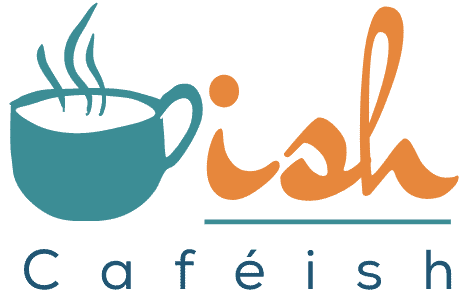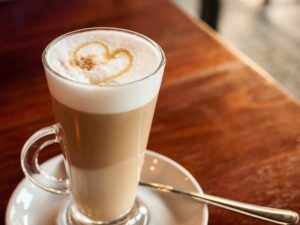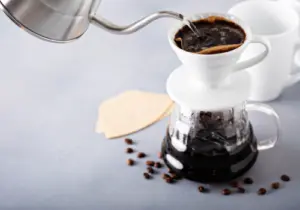Cold Brew vs French Press: What’s The Real Difference?
Disclosure: This post contains affiliate links and I may earn a small commission (at no extra cost to you) if you click through and make a purchase. Thanks in advance – I really appreciate it!
Have you ever been stuck deciding between a Cold brew or French press? Don’t worry, many of my friends debate these brewing methods in hopes to discover which one is right for their morning cup. When they ask me, I always tell them that they’re both amazing options and they won’t regret choosing either.
Although both Cold brew and French Press are manual coffee brewing processes, they differ a lot from one another.
Key Takeaways:
Cold Brew vs French Press
- Cold brew coffee uses a method of steeping coffee grounds in cold water for a long time (12-24 hours). Whereas the French Press method entails putting coffee grounds into a carafe, pouring in hot water, letting it steep and then pushing down a plunger to separate the brewed coffee for drinking.
- Cold-brew has higher amount of caffeine than French Press.
- Cold-brewed coffee is sweeter, more delicate, and smoother on the tongue.
- French press coffee tastes intense and full-bodied.
This blog post will go in-depth about the major differences between the two so you can make an informed decision on which type of coffee you want as your morning pick me up.
What’s the difference between Cold brew and French press?
Cold brew and French press are two different ways of brewing coffee. A French press uses hot water and pressure to extract flavor from ground beans, whereas a pour-over uses gravity and time.
Here’s a brief rundown of the major differences between cold brew and the French press coffee.
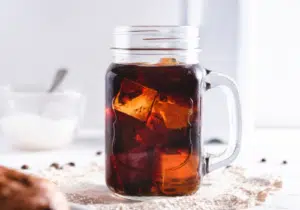
Cold Brew
- What you’ll need: Coffee, water, any container.
- Brew time: 12-24 hours
- Taste : Smooth, balanced sweet taste of coffee.
- Caffeine: 200mg caffeine/16 fl. oz.
- Shelf life: Up to 2 weeks.
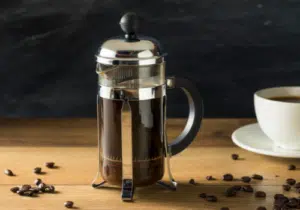
French Press
- What you’ll need: Coffee, hot water, French press coffee maker.
- Brew time: 4-6 minutes
- Taste: Bold, strong, espresso-like flavor.
- Caffeine: 110mg caffeine/16 fl. oz.
- Shelf life: For immediate consumption.
What is Cold Brew coffee?
If you’re a coffee lover and looking for a more robust flavor, cold brew might be your thing.
Cold brew is made by steeping coarsely ground beans in cold water for 12-24 hours to extract the full flavors of the beans.
The result is an intense, low acid drink that can last up to two weeks in the refrigerator without going bad.
Cold Brewing devices include the Toddy brewer, Filtron, the Kyoto Drip Tower, Yama Drip Tower, a French Press, or a mason jar.
Now let’s talk about some unique characteristics of cold brew that differentiate it from French Press coffee.
Cold Brew Characteristics
1. Cold brew uses cold/room temperature water.
Unlike French press coffee, cold brew uses cold water and time rather than heat for extraction. The result is a very smooth and rich beverage with a heavier mouthfeel, syrupy flavor notes, and low acidity.
Because cold brew steeps in water for an extended period of time, it makes it the easiest of all brewing methods and requires no technical skills.
2. Cold-brew grind size.
The grind size for a cold brew is very important to the taste of your drink because here is where you get that nice balance between the coffee’s oils and acids, which gives it its distinctive smooth taste.
Cold brew uses an extra coarse grind size that ensures sweet as well as a bold flavor without much acidity or bitterness, and less oil.
3. Cold-brew has high caffeine.
Since cold brew is brewed with a higher ratio of coffee to water, the concentrate that is made can have considerably more caffeine than the same volume of hot French press coffee, or even espresso. This is in spite of hot brewing being able to more effectively extract caffeine and other compounds.
However, since you don’t drink cold brew concentrate straight and it is typically cut with water or creamer, which levels things out a bit.
Still, even some cold brews that are brewed and sold contain higher levels of caffeine than your standard French press coffee.
4. Cold brew has a smooth flavor.
Cold-brewed coffee tends to be sweeter, more delicate, and smoother on the tongue.
It is mild, sweet, and smooth, with minimal bitterness and acidity, and serves as a perfect base for cocktails, mocktails, and other cold coffee drinks.
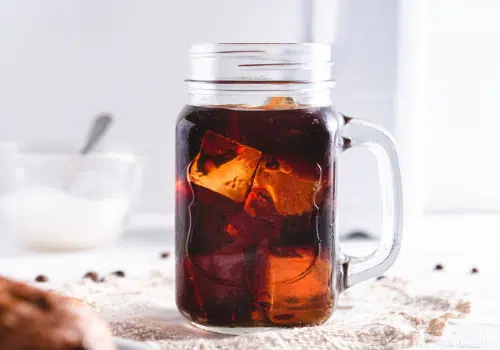
5. You can use old coffee beans for cold brew.
You’ll get the best-tasting coffee if you grind and use fresh coffee beans for French press brewing. When it comes to the cold brew method, the process is designed not to extract all the intricate flavors.
So you can use your old coffee beans in the cold brew method and it would still result in a sweet and mellow cold brew coffee.
6. Cold Brewing Methods
There are two main methods that you can use to make your cold brew coffee.
a) Immersion Brewing
Immersion cold brew is the simplest way possible to make coffee. You put ground coffee into a container of water and let it sit. No heat or special equipment is necessary, just time.
It’s also very hard to mess up. You can let the cold brew sit for 12, 18, or even 24 hours and the taste won’t change all that much.
Immersion is the definition of “set it and forget it.” Start it at night and wake up in the morning to a container full of coffee.
Immersion brewing creates the smoothest, tastiest cup of coffee around. Due to the long steep time and course grounds used, immersion cold brew has a very mellow, balanced flavor.
It also extracts 66% less acid from the coffee beans than other brew methods. This is great news for people with sensitive stomachs.
Immersion is the easiest and most reliable method for doing so. It’s why over 70% of people who make cold brew do so using the Immersion method.
If you too are planning to make cold brew coffee using the immersion method then I highly recommend the KitchenAid Cold Brew Maker. It’s made of steel and thick glass, with a built-in handle and a spigot for dispensing cold brew—perfect if you have a shelf to set it on, in, or out of the fridge.
Prices pulled from the Amazon Product Advertising API on:
Product prices and availability are accurate as of the date/time indicated and are subject to change. Any price and availability information displayed on [relevant Amazon Site(s), as applicable] at the time of purchase will apply to the purchase of this product.
b) Ice Drip Brewing
Ice-drip brewing takes more time and effort than the standard immersion method and requires a unique tower mechanism to drip iced water on top of fresh coffee grounds slowly.
Slow drip cold brew makers are normally made of clear glass to allow easy observation of the slow drip process.
The slow drip method doesn’t muddle the flavors of the coffee like Immersion cold brew, which steeps coffee grounds in all of the water overnight.
The consistent slow drip brewing process better captures the nuances of flavor and makes this method ideal for making a light, bright, flavorful cold brew.
Unless you want to build a homemade tower out of water bottles, you will have to buy a dedicated slow drip cold brew maker, which can get a bit pricey.
Cold Brew Pros & Cons
Pros
- The cold brew is easy to make and requires no special equipment like a machine.
- It’s a refreshing way to get your caffeine when it’s hot outside.
- The cold extraction process actually pulls out less of coffee’s bitter compounds resulting in a sweeter overall taste.
- It allows the user to tweak variables like coffee origin, grind size, and brewing time.
Cons
- High levels of caffeine can have an adverse effect on some.
- Long brew time may not be suitable for everyone.
How To Make Cold Brew?
If you’re put off by cold brew coffee’s long steeping time, don’t be. It’s easy to make a big batch at once, so you can keep it on hand in your fridge at all times. Here’s how you can make it!
What you’ll need:
- Coffee beans
- Grinder
- Mason jar/container
- Filtered water
Instructions:
Coarsely grind your coffee. If you don’t have a coffee grinder, grind the beans at the store yourself, or get freshly ground beans from a local coffee shop or roaster.
Place the coffee grounds in a large Mason jar and pour filtered water on top. I like to use a 1:2 coffee to water ratio, or 1 1/2 cups of grounds for every 3 cups of water.
Stir to combine the water and the coffee grounds, and let the jar sit, covered, at room temperature for 12 to 24 hours. The longer the coffee steeps, the stronger it will be.
Once it has sat for and “brewed” in the refrigerator, all you need to do is strain it!
Pour the coffee through the strainer and store it, covered, in the fridge.
When you’re ready to enjoy your coffee, pour it over ice and dilute it with more water or milk to taste.
Here’s a video that can help you in making your batch of cold brew at home.
What is French Press coffee?
The French press is also known as a coffee press or a cafetiere. It is a popular brewing method because it’s an easy and affordable way to make delicious fresh coffee in the comfort of your own home.
The French press machine steeps coffee grounds in hot water, then separates the grounds out to leave only the coffee liquid.
The hot water is poured into a cylindrical glass carafe holding the coffee grounds.
The grounds are left to steep, and then the plunger with a stainless steel filter is pushed to the bottom of the carafe to press the grounds.
A French press also uses the immersion brewing method. The difference between a French press immersion brewing and immersion brewing for a cold brew, for instance, is that the water is heated for a French press and kept room temperature or cooled for a cold brew.
French Press Coffee Characteristics
1. French press allows for steeping in hot water.
To make French press coffee, you use coffee grounds that steep for several minutes in hot water. The end result is a mouth-watering cup of coffee. Because the grounds are steeped, the coffee tastes better.
French press doesn’t soak up flavor and adds tiny bits of coffee grounds in the coffee that percolates flavor.
2. No impurities.
French press doesn’t allow any impurities in your coffee. You get complete saturation of grounds. The French press does not allow you to miss any of the grounds. This means you are getting complete saturation of the coffee and oils.
Using a French press means that everything except the ground coffee is in the cup. You taste all the flavors, which adds to the experience.
3. French press brews the coffee at the right temperature.
French press maintains the right water temperature throughout the process, which makes a difference in how the coffee is brewed.
The Temperature of your brew water is the final control variable, and it will relate directly to your rate of extraction (hotter water causing faster extraction and vice versa).
Remember that your “temperature” isn’t necessarily the temperature in your kettle, but rather the temperature of the water throughout the brewing process in the brewer itself.
4. French press grind size.
The grind setting that you choose will also greatly impact your total extraction by affecting the rate at which coffee flavor will dissolve and extract out of your grounds.
The commonly accepted coarseness for the french press has been “very coarse” for a long time now, but more and more lately loads of pros are recommending a setting closer to a standard drip grind.
Regardless of which grind you decide to go with, be sure that it pairs well with your chosen contact time.
5. French press flavor & taste.
One of the hallmarks of good French press coffee is that it is known for being intense and full-bodied. The method allows for more of the beans’ oils to remain in your cup which adds to the richness.
Also, since the grinds remain in contact with the coffee, the coffee extraction never ends, creating an oily and bold taste. If you prefer a more strong, bold-tasting coffee, then French press coffee may just be the one for you.
French Press Pros & Cons
Pros
- Brewing coffee with the French press is easy. The only steps in brewing the coffee are grinding coffee beans, boiling water, and immersing them in the beaker.
- It only takes between four and six minutes, so even people who need coffee on the go can find time to make a great cup.
- The time to learn to brew coffee with the French press is relatively low.
- It requires little kitchen space and can be stored in a cupboard and carried in your bag.
- The French press doesn’t use filters or create waste.
Cons
- The French press is a manual operation requiring attention to detail and precise brewing control. You have to monitor the entire brewing process.
- A little variation in the ground, water temperature, time, or coffee-to-water brewing ratio could result in a different taste than you’d prefer.
- You could have sediment or sludge accumulating at the bottom of your cup. Some coffee grounds might be left in the filter or other part of the machine and can’t just be rinsed down the sink drain.
How To Make French Press Coffee
French press coffee is dense and heavy, yet it has its own sort of elegance. As with any method, the devil is in the details.
What you’ll need:
- Coffee beans
- French press
- Grinder
- Kettle
Instructions:
Warm-up your empty French Press by rinsing it with very hot water. This helps maintain the temperature while brewing for the best extraction.
Measure out 56g (about 8 Tablespoons) of coffee and grind it as coarse as breadcrumbs.
Bring enough water to fill the French press to a boil. For a 17-oz press, you’ll need about 350 grams (12 ounces).
Add the coffee grinds to your French press. Then use a kettle to pour enough water in to just wet the beans.
You can give them a quick 3-second stir to disperse the water evenly. Wait 1 full minute for the coffee to puff up and “bloom”.
Then, immediately pour in the rest of the water, give the grounds a quick stir, add the lid on top, and let the coffee brew for 3 more minutes.
Once the total 4 minutes are up, gently (not forcefully) push the plunger down until it firmly reaches the bottom.
Serve it up. Pour coffee into a carafe immediately to avoid over extraction.
Check out this video with a step-by-step tutorial about making a delicious cup of French press coffee.
Cold Brew vs French Press: Which one is better?
When it comes to brewing coffee, cold brew or french press are two of the most popular options. But which one is better? Well, that depends on what you’re looking for in your morning brew.
Cold brew and French press both produce a rich flavor profile with their own unique taste profiles so there’s no clear answer as to which one produces a better cup of joe.
If you enjoy deep flavor notes and bold flavors from beans that have been roasted longer then the Cold brew may be best suited for you. However, if you like an espresso-style drink, try using a French Press instead.
Frequently Asked Questions (FAQs)
Is French press the same as cold brew?
No, the French press is not the same as a cold brew. French press coffee is made in a French press coffee maker where coffee grinds are first steeped for a few minutes and then the coffee maker’s plunger is pushed down to separate the grinds from coffee. Cold brew is a coffee brewing technique were coarsely ground coffee beans are steeped in cold or room temperature water for 12-24 hours.
Is cold brew the same as cold press?
A cold press coffee is typically made in a French press coffee maker where coffee grounds are steeped at room temperature or cold water in a refrigerator for an extended period of time. A cold brew coffee can be brewed in any container by steeping coffee grounds in water for 12-24 hours.

Amit Gupta
Hi, my name is Amit Gupta, and I am the owner and contributor at Cafeish. My obsession with coffee started when I received my first French press as a gift almost ten years ago. Since then, my love of coffee – and the number of coffee gadgets I own – has grown considerably.
Most Popular
ABOUT US
We are a team of coffee affcianados with experience and expertise in making world renowned coffee. In fact, preparing the best coffee ever with a fluffy top reminds us of magic, with secrets of how to achieve each particular effect. Making coffee is not our only hobby, we always keep our ears open as to what’s happening around and what scientists and manufacturers produce for consumers. It’s not an easy task to do – it’s rather time consuming. Hence, Caféish website was launched.
LEGAL DISCLAIMER
Caféish is a participant in the Amazon Services LLC Associates Program, an affiliate advertising program designed to provide a means for sites to earn advertising fees by advertising and linking to Amazon.com. Caféish also participates in affiliate programs with Clickbank and other sites. Caféish is compensated for referring traffic and business to these companies.
